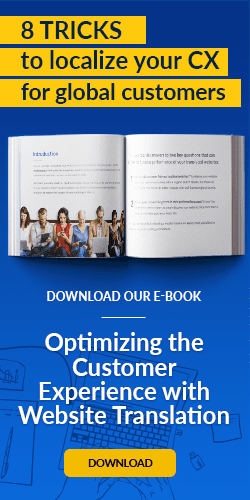As an e-commerce manager, you know just how complicated it is to operate a transactional website, every day. But those daily challenges don’t compare to what you’ll face when it comes time to serve online customers in global markets.
In addition to the daily headaches you must always deal with, you'll also inherit workflows, processes, and integrations for solutions needed for website translation. Unprepared companies quickly wind up with a risky, painful, and expensive set of problems.
Here are the five of the most important ones to understand:
1: Maintaining Consistency
The translatable content for your transactional website, like text and images, lives in a multitude of places—in your CMS, in PIMs, offline catalogues and more.
Locating all that content for translation is a complex task in itself. But ensuring the accurate translation of this disparate content is downright painful and time-consuming, especially if you use manual translation workflows.
You can mitigate the pain points with a technology-powered solution, but most won't play nicely with your existing technology stack. If they do, their compatibility restrictions might lock you in to whatever setup you currently have. CMS upgrades, website redesigns and re-platform projects suddenly become off-limits. That's not good for the long term.
If your website relies on many different technology solutions, any break in consistency—from user experience to website performance—can cause customer confusion, disastrous site downtime, or other major problems.
Some approaches lock you in to their technologies, effectively thwarting your ability to update or switch your CMS.
2: Speed to Market
Between product releases, seasonality and customer demand, retail moves fast. Websites must be updated at a moment's notice.
Traditional website translation workflows can't keep up with the speed of global business. Precious days-or even weeks-can roll by as your new content is identified for translation, gathered and outsourced, and then finally uploaded to your localized website. In the meantime, your timely promotions suffer, and your competition beats you to market-again.
Transactional websites can’t afford to risk any advantage. Legacy translation solutions can slow you down, big time.
3: Functional Conversion Funnels
Conversion funnels are critical for your business, and their content and performance must be absolutely flawless for your global customers. Each step of the funnel must be translated, QA'ed for functionality, and tracked for impact.
When any element of that funnel isn’t translated—or is partially translated, resulting in a mixed-language UX—customers get confused and irritated. If your integrations for local payment options break, or fulfillment solutions for international orders fail or aren’t available, customers get mad.
These issues, and others like them, have high stakes. Alienated customers won't give your website a second chance.
Global customers get mad, fast, when they can’t pay or ship using their preferred methods.
4: Localization
Customers in global markets don’t just speak different languages. They use different measurement units and currencies. They might celebrate different holidays and customs, too. If you want to sell to locals, you gotta sell like a local.
You provide a far more authentic UX when measurements are converted, prices are presented in local currency, and local phone numbers for support and sales are displayed on-site.
Marketing campaigns that speak to cultural values or recognize regional holidays resonate with local customers, and build trust and loyalty. Creating these localizations, however, requires more than language fluency-it takes a fluency in local to craft seamless and sincere localizations.
It also requires a flexible website translation technology that can display this custom content to the right customers, in the right markets and languages, every time.
5: Omnichannel
Your brand presence is more than just your website. It lives on in social media profiles, emails, catalogues, offline marketing and more. Your brand voice, messaging and image must be on-point and consistent in these channels, in global markets.
Maintaining brand consistency across multiple channels in multiple languages can be challenging. With so much content living on so many platforms, it's easy to lose track of what translatable content lives where.
While some content can get totally overlooked, overlapping content can get re-translated unnecessarily. That wastes time and money.
With legacy approaches, efficiently tracking and translating multichannel content isn’t just a pain—it’s practically impossible.
The Solution
These are just a handful of obstacles that can thwart your e-commerce ambitions in global markets. But you can effortlessly sidestep them with the right website translation solution.
As you explore your options, look for solutions built with the express purpose of minimizing the operational complexity and cost of website localization. Fully turn-key approaches are especially effective, since they manage, monitor and host your multilingual website for you-which eliminates in-house effort at launch and ongoing.
Fast deployment and translation updates are also critical. The best solutions can fully translate and launch websites in as little as 30 days, and publish new translated content within 24 hours.
These solutions have technologies that handle all the under-the-hood complexities that make website translation such a burden for your IT team, too. The best use superior proxy-based technology that can be used with any tool, handle any site, and read any programming language.
That means the solution gets along with your CMS, while providing thorough, expertly crafted brand-perfect translations for your online and multichannel content, all around the world.
Last updated on January 16, 2018
